With so much attention given to STEM subjects these days, it might be easy to overlook the impact of arts education. But the value of the arts lies beyond learning to carry a tune or draw a straight line.
In its Strategic Plan: Vision 2020, Wake County Public Schools lays out its mission to graduate students who can collaborate, be creative, communicate and think critically — the four C’s.
“Those four important components happen every day in the art room,” said Mary-Swan Marshallsea, a visual arts educator at Pleasant Grove Elementary in Morrisville.
“Allowing students to take creative risks and to be able to problem-solve — that starts at such an early age,” she said. “It gives them a sense of innovation, how to invent, how to create — all those things that are important for our next generation.”
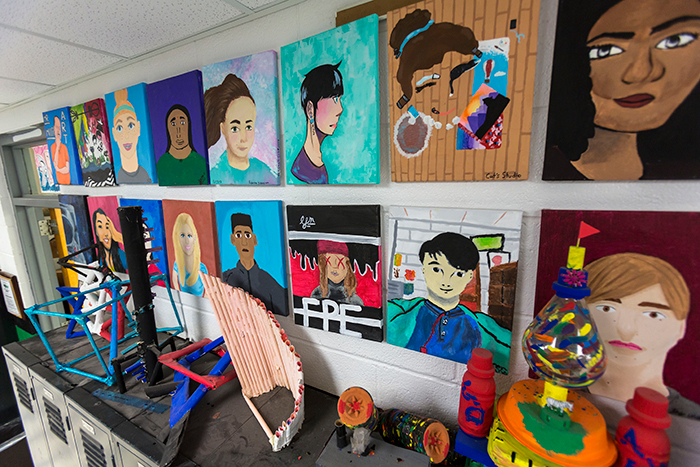
Outside his classroom, Lial Miller displays self-portraits painted by his former students at West Cary Middle School. Miller came to the school two and a half years ago to restart the visual arts program, which had been shelved for five years.
Teamwork and geography
A recent project demanded Marshalsea’s third-graders use all four C’s with some geography thrown in. Each of seven groups researched a world city — New York City, Washington, Paris, Sydney, Stockholm, Mexico City and Nairobi, Kenya — and made large mixed-media landscapes. The Australia group, for example, did a huge picture of the Sydney Harbour Bridge.
“It was fantastic,” she said. “The children loved it. They collaborated; they had to talk about the different ideas. Some of the children had to take the lead, whereas some of the group had to take a back seat.”
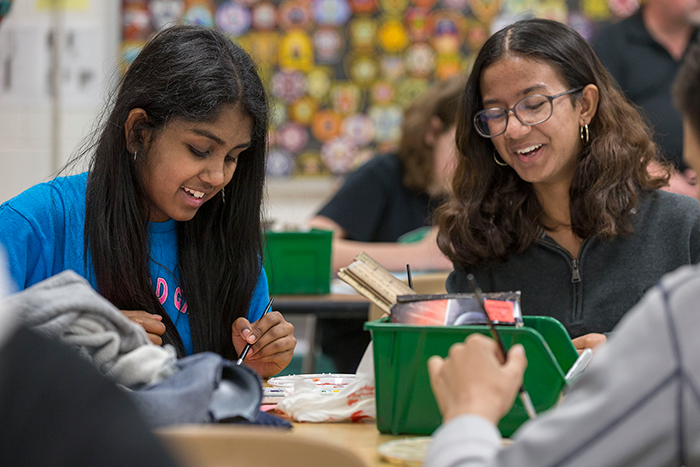
Nikhita Kasireddy, left, and Kiki Bhattarai, both 13, chat as they work on their watercolor landscapes during Miller’s art class. Studies show that arts education helps students collaborate, receive and offer constructive criticism, and listen actively to others’ ideas.
In her classes, it is common for Marshallsea, who has taught art for more than 30 years, to incorporate lessons in language arts, reading, science and mathematics.
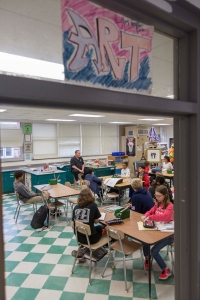
Studies show this integration of art with other subjects helps engage students and enables them to retain information.
Freddie Lee Heath, the senior administrator for arts education with Wake County Public Schools, says the best teaching environment is when all educators are working together — helping students connect with the curriculum.
“Arts should be a part of every subject,” he said.
Better outcomes for all students
Heath also stresses that art and arts-integrated classes can better engage at-risk students.
“The arts and the electives are one of the best ways for children who feel disenfranchised from the school day to feel like they are part of the school community,” he said.
“If there’s a student who is not doing well in any of their classes, …when they get into the arts, physical education or some of the electives, it’s a chance for them to feel successful in the school day.”
Lial Miller, a visual arts teacher at West Cary Middle School, agrees that art can be a level playing field. He also says the way it is taught encourages participation, work and perseverance.
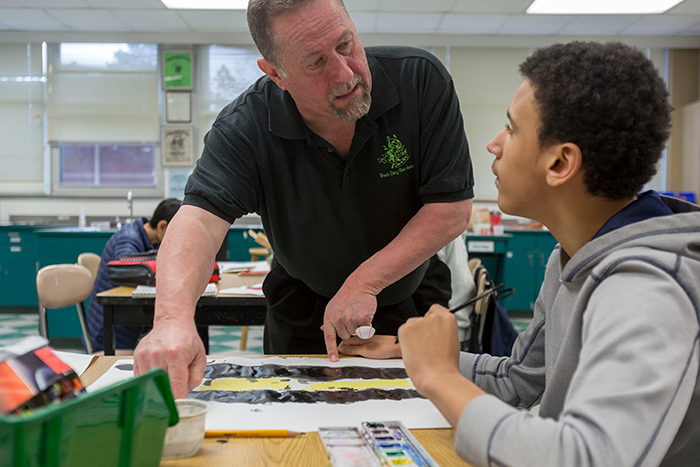
Lial Miller gives Jacob Zuncich, 14, a few tips on how he can make his black mountains stand out from each other. “There are so many different media and styles, that everybody can find something they enjoy and are good at,” says Miller.
“I teach that there is no wrong answer in art, other than not trying. I don’t care if you are my best or worst artist as long as you are giving me an honest attempt,” he said. “As long as you’re working hard, I will not give you bad grades.”
Boosts literacy and English language skills: When art is combined with reading lessons, all students benefit, especially English-language learners and low-income students.
Advances math achievement: Students who study music consistently score better on math assessments than their non-arts peers.
Engages and motivates students to learn: Students who struggle academically are more likely to participate in the arts and arts-integrated classes.
Develops critical thinking: Arts education develops students’ critical thinking skills — including skills for comparing, hypothesizing, critiquing and exploring alternative viewpoints.
Source: Arts Education Partnership, 2013
One of Miller’s students has moved around a lot and frequently misses school. The young man says he likes drawing and painting, because “art gets my mind off stuff.”
“If you look at his work, it’s more work than he’s done in a lot of his other classes,” Miller said of this student. “It’s cool what he’s doing for me, but really he’s doing it for himself. He just doesn’t know it.”
Beyond the classroom
Hard work and participation are key to success in Miller’s classes, but he encourages his students to think outside the classroom. Several of his students have earned recognition in statewide arts competitions.
And as a way to connect his lessons to real-world challenges, Miller looks for opportunities to partner with local businesses.
“Last year, I just happened to be eating lunch at Ashworth’s Pharmacy, and the walls were kind of bare. I said to the owner, ‘Do you want some student work to display?’ ”
Paul Ashworth had a better idea. It was the Cary pharmacy’s 60th anniversary, and he asked Miller if the students could design T-shirts for the occasion. Out of dozens of submitted designs, two were chosen for the shirts, earning cash prizes for the artists. A third student was paid $40 for the winning slogan, “Serving Smiles for 60 Years.”
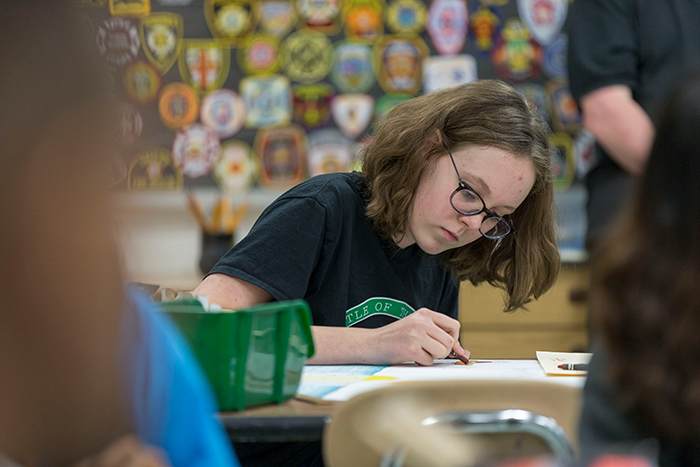
Alexis Cope, 14, draws an alien world with a purple sky populated by girls with wings. “Art is one of my biggest passions,” she says. “It’s really cool to be in art class, because at my elementary school we didn’t have one.”
“I was tickled that Mr. Ashworth would get involved with the students,” said Miller. “The next thing you know, he’s paying them big money for a T-shirt design.”
West Cary students also designed holiday cards for S&A Communications, a division of S&A Cherokee, which also owns Cary Magazine.
“Getting involved with our community is a great way for our school to show how hard these students work,” said Miller.
These partnerships, he says, are also a way to remind the public that a vibrant arts education program can be valuable for the community as a whole — not just students.
Focus on the arts
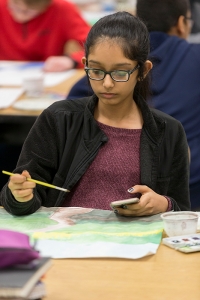
These reminders are important, agrees Marshallsea, especially for those who might see arts as non-essential.
Last year, many N.C. schools proposed cutting arts, music and physical education programs to pay for the classroom teachers needed to comply with a state directive to reduce class sizes in kindergarten through third grade. The change was to go into effect for the 2018–19 school year, but in February, the General Assembly voted to delay the class-size reduction until 2021–22. An additional $61.4 million a year was also set aside to pay for arts and P.E. teachers.
“Even though for now we feel OK regarding arts in schools, we still need to focus on it,” said Marshallsea.
“We shouldn’t overlook the wonderful things we have in Wake County, particularly in art, music, dance and drama. All those things help our children learn, grow and be the best that they can be.”
- Tough Cookies
- Family Style
- The Soft Skills of Therapy Dogs
- For Entrepreneurs, Help is Crucial
- Yes Solar Solutions: A Reputation for Quality
- Chatham Station: The New Venue in Town
- The Clan Cuphea
- Smart Arts
- Call the Hops by Fortnight Brewing Company
- Pet Parade
- Doc Porter’s Bourbon Whiskey
- Transitions LifeCare
- Pick, Bake and Eat Spring’s Bounty of Berries



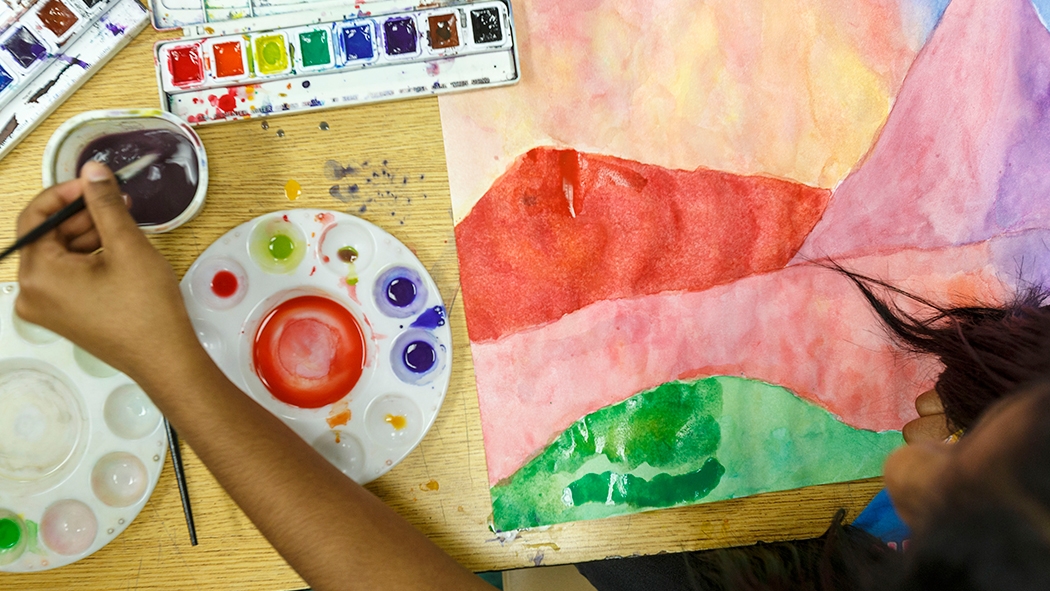



Mr miller had left our school this year during winter break though. Why?